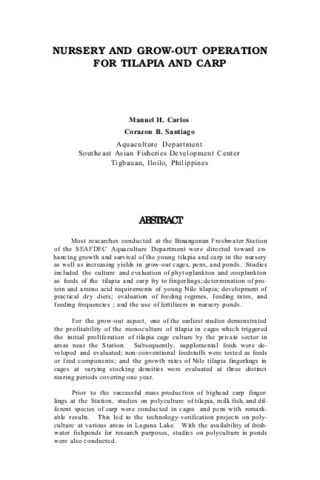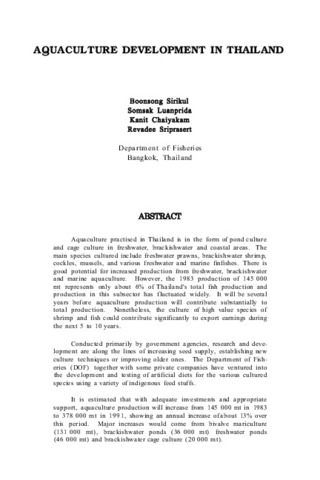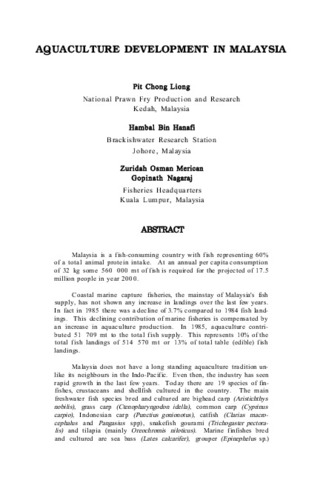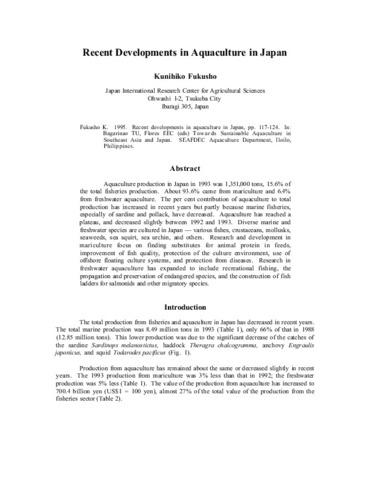Nursery and grow-out operation for tilapia and carp

ရှာဖွေ/ဖွင့်ပါ။
ရက်စွဲ
1988Page views
1,259
Share
စိတ္တဇ
Most researches conducted at the Binangonan Freshwater Station of the SEAFDEC Aquaculture Department were directed toward enhancing growth and survival of the young tilapia and carp in the nursery as well as increasing yields in grow-out cages, pens, and ponds. Studies included the culture and evaluation of phytoplankton and zooplankton as feeds of the tilapia and carp fry to fingerlings; determination of protein and amino acid requirements of young Nile tilapia; development of practical dry diets; evaluation of feeding regimes, feeding rates, and feeding frequencies ; and the use of fertilizers in nursery ponds.
For the grow-out aspect, one of the earliest studies demonstrated the profitability of the monoculture of tilapia in cages which triggered the initial proliferation of tilapia cage culture by the private sector in areas near the Station. Subsequently, supplemental feeds were developed and evaluated; non-conventional feedstuffs were tested as feeds or feed components; and the growth rates of Nile tilapia fingerlings in cages at varying stocking densities were evaluated at three distinct rearing periods covering one year.
Prior to the successful mass production of bighead carp fingerlings at the Station, studies on polyculture of tilapia, milk fish, and different species of carp were conducted in cages and pens with remarkable results. This led to the technology-verification projects on polyculture at various areas in Laguna Lake. With the availability of freshwater fishponds for research purposes, studies on polyculture in ponds were also conducted.
Suggested Citation
Carlos, M. H., & Santiago, C. B. (1988). Nursery and grow-out operation for tilapia and carp. In J. V. Juario & L. V. Benitez (Eds.), Perspectives in Aquaculture Development in Southeast Asia and Japan: Contributions of the SEAFDEC Aquaculture Department. Proceedings of the Seminar on Aquaculture Development in Southeast Asia, 8-12 September 1987, Iloilo City, Philippines. (pp. 281-292). Tigbauan, Iloilo, Philippines: SEAFDEC, Aquaculture Department.
ဘာသာရပ်
stocking density  ; cultured organisms; induced ovulation
; cultured organisms; induced ovulation  ; freshwater fishes
; freshwater fishes  ; fertilization
; fertilization  ; fish larvae
; fish larvae  ; sex hormones
; sex hormones  ; breeding stock
; breeding stock  ; hatching
; hatching  ; fish culture
; fish culture  ; aquaculture techniques
; aquaculture techniques  ; seed (aquaculture)
; seed (aquaculture)  ; feeds
; feeds  ; sex ratio
; sex ratio  ; fry
; fry  ; husbandry diseases; pond culture
; husbandry diseases; pond culture  ; polyculture (aquaculture)
; polyculture (aquaculture)  ; spawning
; spawning  ; seed production
; seed production  ; monoculture
; monoculture  ; rearing techniques
; rearing techniques  ; aquaculture facilities
; aquaculture facilities  ; water hardness
; water hardness  ; sexual maturity
; sexual maturity  ; cage culture
; cage culture  ; feeding experiments
; feeding experiments  ; freshwater aquaculture
; freshwater aquaculture  ; Hypophthalmichthys nobilis
; Hypophthalmichthys nobilis  ; Hypophthalmichthys molitrix
; Hypophthalmichthys molitrix  ; Cyprinus carpio
; Cyprinus carpio  ; Oreochromis mossambicus
; Oreochromis mossambicus  ; Brachionus plicatilis
; Brachionus plicatilis  ; Euglena
; Euglena  ; Oreochromis niloticus
; Oreochromis niloticus  ; Bay, Laguna de
; Bay, Laguna de 
 ; cultured organisms; induced ovulation
; cultured organisms; induced ovulation  ; freshwater fishes
; freshwater fishes  ; fertilization
; fertilization  ; fish larvae
; fish larvae  ; sex hormones
; sex hormones  ; breeding stock
; breeding stock  ; hatching
; hatching  ; fish culture
; fish culture  ; aquaculture techniques
; aquaculture techniques  ; seed (aquaculture)
; seed (aquaculture)  ; feeds
; feeds  ; sex ratio
; sex ratio  ; fry
; fry  ; husbandry diseases; pond culture
; husbandry diseases; pond culture  ; polyculture (aquaculture)
; polyculture (aquaculture)  ; spawning
; spawning  ; seed production
; seed production  ; monoculture
; monoculture  ; rearing techniques
; rearing techniques  ; aquaculture facilities
; aquaculture facilities  ; water hardness
; water hardness  ; sexual maturity
; sexual maturity  ; cage culture
; cage culture  ; feeding experiments
; feeding experiments  ; freshwater aquaculture
; freshwater aquaculture  ; Hypophthalmichthys nobilis
; Hypophthalmichthys nobilis  ; Hypophthalmichthys molitrix
; Hypophthalmichthys molitrix  ; Cyprinus carpio
; Cyprinus carpio  ; Oreochromis mossambicus
; Oreochromis mossambicus  ; Brachionus plicatilis
; Brachionus plicatilis  ; Euglena
; Euglena  ; Oreochromis niloticus
; Oreochromis niloticus  ; Bay, Laguna de
; Bay, Laguna de 
Taxonomic term
စုစည်းမှုများ စုစည်းမှုများ
- ADSEA '87 [20]
Related items
Showing items related by title, author, creator and subject.
-
Aquaculture development in Thailand
Sirikul, Boonsong; Luanprida, Somsak; Chaiyakam, Kanit; Sriprasert, Revadee (Aquaculture Department, Southeast Asian Fisheries Development Center, 1988)Aquaculture practised in Thailand is in the form of pond culture and cage culture in freshwater, brackishwater and coastal areas. The main species cultured include freshwater prawns, brackishwater shrimp, cockles, mussels, ... -
Aquaculture development in Malaysia
Liong, Pit Chong.; Hanafi, Hambal Bin.; Merican, Zuridah Osman.; Nagaraj, Gopinath. (Aquaculture Department, Southeast Asian Fisheries Development Center, 1988)Malaysia is a fish-consuming country with fish representing 60% of a total animal protein intake. At an annual per capita consumption of 32 kg some 560 000 mt of fish is required for the projected of 17.5 million people ... -
Recent developments in aquaculture in Japan
Fukusho, K. (Aquaculture Department, Southeast Asian Fisheries Development Center, 1995)Aquaculture production in Japan in 1993 was 1,351,000 tons, 15.6% of the total fisheries production. About 93.6% came from mariculture and 6.4% from freshwater aquaculture. The per cent contribution of aquaculture to total ...




